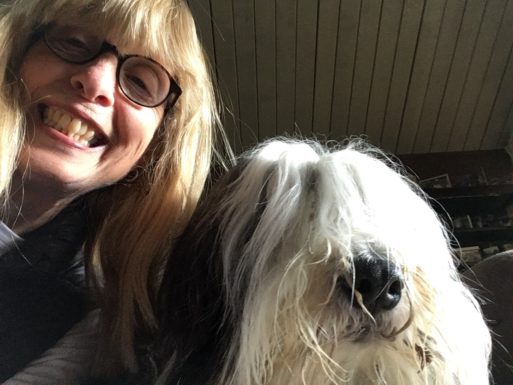
Susan M. Weisberg is a Licensed Clinical Social Worker who works as a hospice social worker in the South Bay area near San Francisco. In addition to her education and Social Work License, Susan received specialized training in end-of-life care at the Smith College of Social Work as well as a one-year Palliative Care Fellowship at the V.A. Hospital Hospice in Palo Alto. Her career spans 45 years of medical social work.
Editor’s Note: This interview has been edited for length and readability.
Melissa Gouty: First of all, thank you for taking the time to talk to me today about your work. Can you define what a hospice social worker does? Is a hospice social worker different than a social worker?
Susan Weisberg: We are defined by the settings we work in. Social work is social work, irrespective of where you work. So if you’re in a school setting, you’re a school social worker. You’re going to go in and help students with adjustment problems, parental problems, any kind of social problems that might affect the child and their ability to cope with the world.
I do social work for hospice patients.
Melissa: What is your background?
Susan: My background is medical social work. I worked for 22 years in Radiation and Medical Oncology at Stanford Medical Center where we helped people with adjustment to illness, managing the trajectory of whether they would survive or die. During that time, we had many young people who were being treated for Hodgkin’s and lymphoma, and they were often cured. So they would be plucked out of their lives, have to go through treatment, and then go back to their lives. We would help these people get connected with government agencies that helped retrain them or helped them go back to school … get back to a life.
In hospice work, we do the same thing. We meet people when they have been given a terminal diagnosis. Some people want to go down the existential path and talk about their lives. Some people just do not want to go there. They do not want to delve into things. They just want to make the best of every day.
Some people cannot manage at home, so we help people with finding caregivers, or we help them hire someone, or we help them find other living situations because they are alone.
Melissa: What was the impetus for making the switch from the oncology to the hospice work?
Susan: I was in oncology for so long, and maybe people would survive the treatment, and then they would return, and we would treat them again, and then they would return. It just seemed like the natural progression to move toward palliative care. I had also worked as a visiting nurse in New York in the ’70s, before the Medicare hospice benefit, so I’ve always been drawn to that area, maybe because my parents died when they were in their 50’s.
Melissa: Did your parents die of illnesses?
Susan: I experienced death at a young age. My dad died when I was 16, and my mother died when I was 27. So I experienced things earlier in life than a lot of my contemporaries.
My mother was treated at Sloan-Kettering which is a fine hospital, and she died in 1972. In those days they didn’t have too many social workers there. Nobody was addressing psychosocial issues.
I shifted my focus to medical social work because of my mother’s experience. It really did have an impact on me. I was young and I thought, “Gee, what’s missing here?”
Well, I went to work at Stanford as a social worker in ’82, and my mother died in ’72. In that ten-year period, Sloan-Kettering had instituted a fabulous social work department. They really got their act together and began to deal with the things that would happen to people after treatment.
Melissa: Your duties are totally based on social work, right? You’re not a nurse?
Susan: No. I’m not a nurse. I’ve been around medical professionals for a long time, and I learned a lot about medicine, and I was eager to know more. One of the advantages of working around a major medical center is that there were all these opportunities to learn that I could go to.
Melissa: You had a passion for it.
Susan: Well, you have to be a curious person to be a good social worker.
 My area now is hospice social work. I help patients and families navigate through terminal illness. Sometimes, we have young families, so I do my best to support the kids and talk to them about their feelings about death and dying. We really work from people’s own strengths. We let them be their own guiding light. I think that’s very important.
My area now is hospice social work. I help patients and families navigate through terminal illness. Sometimes, we have young families, so I do my best to support the kids and talk to them about their feelings about death and dying. We really work from people’s own strengths. We let them be their own guiding light. I think that’s very important.
In addition to my hospice work, I do some caregiver groups. A wonderful woman named Robin Riddle has this incredible program for caregivers whose husbands have Parkinson’s. We talk a lot in our groups about anticipatory grief. Much of what a caregiver is dealing with is the changing of their lives and the loss of the identity of their spouse or their parent. Coping with that kind of grief is very painful, and it can be a long process of loss. I always say behind every caregiver is a care-griever.
Melissa: What are some of your most memorable experiences?
I met a young family from Sri Lanka. The daughter had a horrible disease, and she was 8 or 9, and we couldn’t do anything for her. The family wanted to take her home to die, but they didn’t have any money. So I embarked on this fundraising campaign. I don’t recall how I did this, but I must have called a reporter at the television station. The television station came over and they did a little two-minute clip on the news. All of a sudden, it’s like manna from heaven. People started sending in donations. I think we raised $12,000! That does not seem like a lot of money, but in 1983 or ’84 it was enough to get the family home.
You know, sometimes you think about the things in your life that may have made a difference for someone else. Social work does that.
Then I had this other gentleman, a Filipino man who had this terrible head and neck cancer. He was an extremely devout Catholic, and what he wanted to do was live in a monastery somewhere in California under the radar and polish the kitchen furniture and sweep. This is what social work is all about, so I got a list of all these monasteries in California, and I found one he could go to. I got him a bus ticket, and he was able to go there and serve as he wished. He lived there for three or four years.
I remember going to visit him and he showed me the kitchen. The appliances were gleaming, so shiny you could see your face in them. He was so proud. He just wanted to be with these monks who were kind and compassionate. When he died, he was buried with the monks.
I had wonderful colleagues too. One of them had a patient who wanted to drive a sports car, so he went to a Maserati dealer, and he got this guy a test drive in a Maserati. It just was fabulous. Why not, right?

Credit: Raycantenamaserati.com
Melissa: I hope if I ever need a hospice social worker that I get someone as kind and compassionate and creative as you are.
Susan: You just have to do that. That’s what I would want …to do unto others.
What I also need to say is that we have the most wonderful nurses. They are extraordinary. Remarkable people, great thinkers on their feet. And the Home Health Aides! Oh my. I’ve gone to memorial services and funerals where the Home Health Aides show up. The families are embracing them like they are the most important people at the funeral. So many people in social work just go far above their job duties to help someone else.
Melissa: This has been a moving, wonderful, experience for me. Thank you for sharing your experiences and for helping me to understand the role of a social worker in hospice care.
Susan: My pleasure.
Join us next week for part two of our interview with Hospice Social Worker Susan Weisberg where she will discuss how social work has changed over the last 40 years.

 What Does a Hospice Social Worker Do?
What Does a Hospice Social Worker Do?


 Funeral Home Owner Chris Johnson Spending Halloween in Jail
Funeral Home Owner Chris Johnson Spending Halloween in Jail
 Our Monthly Tip: Toast a Loved One with a Personalized Glass
Our Monthly Tip: Toast a Loved One with a Personalized Glass
 My Cousin’s Death Taught Me the Meaning of Life
My Cousin’s Death Taught Me the Meaning of Life














